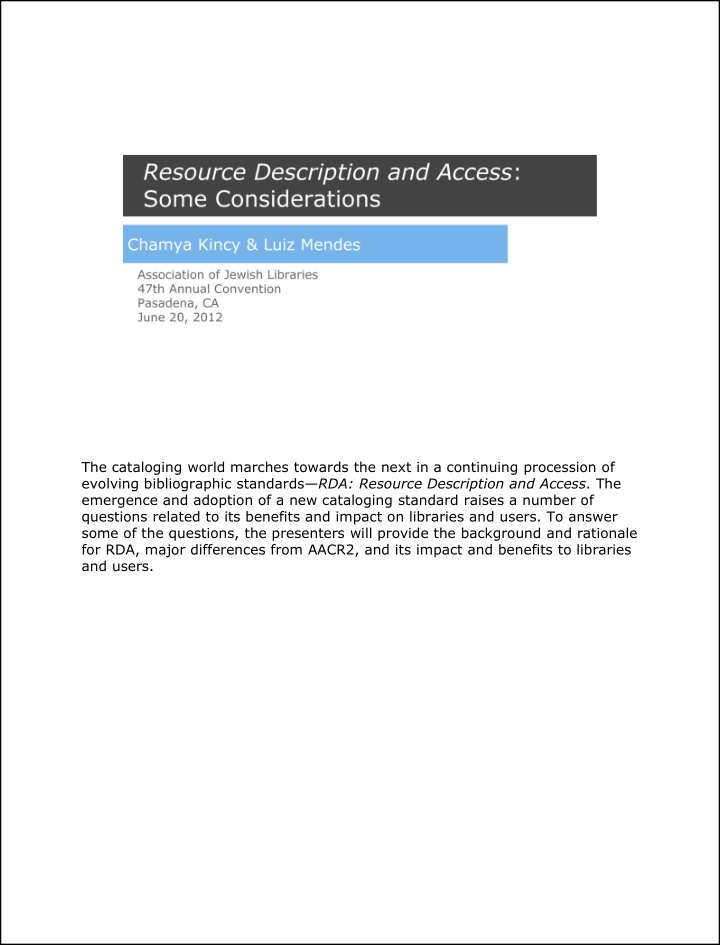



The cataloging world marches towards the next in a continuing procession of evolving bibliographic standards — RDA: Resource Description and Access . The emergence and adoption of a new cataloging standard raises a number of questions related to its benefits and impact on libraries and users. To answer some of the questions, the presenters will provide the background and rationale for RDA, major differences from AACR2, and its impact and benefits to libraries and users.
Stronger emphasis on helping users find, identify, select, and obtain resources
A conceptual/abstract model that re-thinks the bibliographic universe. • Entities : key objects of interest to users of bibliographic data o 3 groups • Attributes are characteristics of resources that serve as the means by which users can formulate queries and interpret results when seeking information about a particular entity. Attributes help the user identify , select , and obtain resources. • Relationships serve as the vehicle for depicting the link between one entity and another, thus helping the user “navigate” through the bibliographic universe. Relationships help the user find resources associated with other resources, resources associated with the persons, families, and corporate bodies responsible for them, and works of a specific subject matter.
record information for organizing resources in a meaningful way
A conceptual/abstract model that re-thinks the bibliographic universe. • Entities : key objects of interest to users of bibliographic data o 3 groups • Attributes are characteristics of resources that serve as the means by which users can formulate queries and interpret results when seeking information about a particular entity. Attributes help the user identify , select , and obtain resources. • Relationships serve as the vehicle for depicting the link between one entity and another, thus helping the user “navigate” through the bibliographic universe. Relationships help the user find resources associated with other resources, resources associated with the persons, families, and corporate bodies responsible for them, and works of a specific subject matter.
Highlight of changes Benefits Impacts Changes Terminology and "insctructions" for description Mention summary of terminology between AACR2 and RDA •Replacement of GMD by content, carrier, media •Transcription of title proper (inaccuracies: ―transcribe as you see it ‖ ) •Recording of statement of responsibility •Abbreviations •Elimination of rule of three •Presentation of data (encoding of data in ISBD)
Benefits Impacts (Workflows, Local policy decision, ILS systems) ILS Vendors’ updates to incorporate RDA into their system National policies and decisions •Local policies and decisions on workflows Training and learning
Coping with a new cataloging code Training (navigating RDA, applying RDA, understanding of conceptual models (FRBR, FRAD); new terminology; new data elements, etc.) Impact on local workflows (decisions & policies) Shelf-ready vs . Copy Cataloging vs. Original Cataloging Changes to local ILS (updating MARC tables, indexing and display of new elements) Cost (implementation, training, work, resources, etc.) Updating data: Changing headings (global change) Changing description
Contents, Features, and Functionality Customizing RDA: ―Features functionality for customizing content and applying it to library workflows. ‖ Level of completeness (core vs . full view) Workflows Changes between AACR2 and RDA: Mapping AACR2 and RDA rules ( a.k.a ― Where’s that rule? ‖ — Concordance) Links to other cataloging tools RDA Online will facilitate cataloging efficiencies Will allow customization to fit specific needs or to catalog specific types of materials Will improve efficiency by retrieving all the rules needed for what is being cataloged Will allow users to add their own notes online Will allow integration of rule interpretations and institutional or network policies Will enable integration with vendor products, improving catalogers’ workflow and performance

Recommend
More recommend